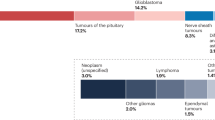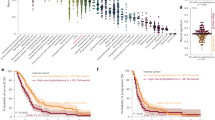Abstract
Overexpression of MYCN is a hallmark of neuroblastoma (NB). ALKR1275Q, an activating mutation of ALK (anaplastic lymphoma kinase), has been found in sporadic and familial NB patients. In this report, we demonstrated that ALKR1275Q knock-in, MYCN transgenic compound mice developed NB with complete penetrance. Transcriptome analysis revealed that ALKR1275Q globally downregulated the expression of extracellular matrix (ECM)- and basement membrane (BM)-associated genes in both primary neuronal cells and NB tumors. Accordingly, ALKR1275Q/MYCN tumors exhibited reduced expression of ECM/BM-related proteins as compared with MYCN tumors. In addition, on MYCN transduction, ALKR1275Q-expressing neuronal cells exhibited increased migratory and invasive activities. Consistently, enhanced invasion and metastasis were demonstrated in ALKR1275Q/MYCN mice. These results collectively indicate that ALKR1275Q confers a malignant potential on neuronal cells that overexpress MYCN by impairing normal ECM/BM integrity and enhancing tumor growth and dissemination. Moreover, we found that crizotinib, an ALK inhibitor, almost completely inhibited the growth of ALKR1275Q/MYCN tumors in an allograft model. Our findings provided insights into the cooperative mechanism of the mutated ALK and overexpressed MYCN in the pathogenesis of NB and demonstrated the effectiveness of crizotinib on ALKR1275Q-positive tumors.
This is a preview of subscription content, access via your institution
Access options
Subscribe to this journal
Receive 50 print issues and online access
$259.00 per year
only $5.18 per issue
Buy this article
- Purchase on Springer Link
- Instant access to full article PDF
Prices may be subject to local taxes which are calculated during checkout







Similar content being viewed by others
References
Maris JM . Recent advances in neuroblastoma. N Engl J Med 2010; 362: 2202–2211.
Huang M, Weiss WA . Neuroblastoma and MYCN. Cold Spring Harb Perspect Med 2013; 3: a014415.
Weiss WA, Aldape K, Mohapatra G, Feuerstein BG, Bishop JM . Targeted expression of MYCN causes neuroblastoma in transgenic mice. EMBO J 1997; 16: 2985–2995.
Chen Y, Takita J, Choi YL, Kato M, Ohira M, Sanada M et al. Oncogenic mutations of ALK kinase in neuroblastoma. Nature 2008; 455: 967–970.
George RE, Sanda T, Hanna M, Fröhling S, Wn Luther, Zhang J et al. Activating mutations in ALK provide a therapeutic target in neuroblastoma. Nature 2008; 455: 957–958.
Janoueix-Lerosey I, Lequin D, Brugières L, Ribeiro A, de Pontual L, Combaret V et al. Somatic and germline activating mutations of the ALK kinase receptor in neuroblastoma. Nature 2008; 455: 967–970.
Mossé YP, Laudenslager M, Longo L, Cole KA, Wood A, Attiyeh EF et al. Identification of ALK as a major familial neuroblastoma predisposition gene. Nature 2008; 455: 930–935.
Hallberg B, Palmer RH . Mechanistic insight into ALK receptor tyrosine kinase in human cancer biology. Nat Rev Cancer 2013; 13: 685–700.
Bresler SC, Wood AC, Haglund EA, Courtright J, Belcastro LT, Plegaria JS et al. Differential inhibitor sensitivity of anaplastic lymphoma kinase variants found in neuroblastoma. Sci Transl Med 2011; 9 108ra114.
De Brouwer S, De Preter K, Kumps C, Zabrocki P, Porcu M, Westerhout EM et al. Meta-analysis of neuroblastomas reveals a skewed ALK mutation spectrum in tumors with MYCN amplification. Clin Cancer Res 2010; 16: 4353–4362.
Zhu S, Lee JS, Guo F, Shin J, Perez-Atayde AR, Kutok JL et al. Activated ALK collaborates with MYCN in neuroblastoma pathogenesis. Cancer Cell 2012; 21: 362–373.
Berry T, Luther W, Bhatnagar N, Jamin Y, Poon E, Sanda T et al. The ALK(F1174L) mutation potentiates the oncogenic activity of MYCN in neuroblastoma. Cancer Cell 2012; 22: 117–130.
Heukamp LC, Thor T, Schramm A, De Preter K, Kumps C, De Wilde B et al. Targeted expression of mutated ALK induces neuroblastoma in transgenic mice. Sci Transl Med 2012; 4: 141ra191.
Cazes A, Lopez-Delisle L, Tsarovina K, Pierre-Eugène C, De Preter K, Peuchmaur M et al. Activated Alk triggers prolonged neurogenesis and Ret upregulation providing a therapeutic target in ALK-mutated neuroblastoma. Oncotarget 2014; 5: 2688–2702.
Iwahara T, Fujimoto J, Wen D, Cupples R, Bucay N, Arakawa T et al. Molecular characterization of ALK, a receptor tyrosine kinase expressed specifically in the nervous system. Oncogene 1997; 14: 439–449.
Morris SW, Naeve C, Mathew P, James PL, Kirstein MN, Cui X et al. ALK, the chromosome 2 gene locus altered by the t(2;5) in non-Hodgkin's lymphoma, encodes a novel neural receptor tyrosine kinase that is highly related to leukocyte tyrosine kinase (LTK). Oncogene 1997; 14: 2175–2188.
Saito A, Kanemoto S, Kawasaki N, Asada R, Iwamoto H, Oki M et al. Unfolded protein response, activated by OASIS family transcription factors, promotes astrocyte differentiation. Nat Commun 2012; 3: 967.
Subramanian A, Tamayo P, Mootha VK, Mukherjee S, Ebert BL, Gillette MA et al. Gene set enrichment analysis: a knowledge-based approach for interpreting genome-wide expression profiles. Proc Natl Acad Sci USA 2005; 102: 15545–15550.
Carpenter EL, Mossé YP . Targeting ALK in neuroblastoma—preclinical and clinical advancements. Nat Rev Clin Oncol 2012; 9: 391–399.
Schönherr C, Ruuth K, Kamaraj S, Wang C, Yang HL, Combaret V et al. Anaplastic lymphoma kinase (ALK) regulates initiation of transcription of MYCN in neuroblastoma cells. Oncogene 2012; 31: 5193–5200.
Hasan MK, Nafady A, Takatori A, Kishida S, Ohira M, Suenaga Y et al. ALK is a MYCN target gene and regulates cell migration and invasion in neuroblastoma. Sci Rep 2013; 3: 3450.
Kalluri R . Basement membranes: structure, assembly and role in tumour angiogenesis. Nat Rev Cancer 2003; 3: 422–433.
Buchheit CL, Weigel KJ, Schafer ZT . Cancer cell survival during detachment from the ECM: multiple barriers to tumour progression. Nat Rev Cancer 2014; 14: 632–641.
Lu P, Weaver VM, Werb Z . The extracellular matrix: a dynamic niche in cancer progression. J Cell Biol 2012; 196: 395–406.
Egeblad M, Rasch MG, Weaver VM . Dynamic interplay between the collagen scaffold and tumor evolution. Curr Opin Cell Biol 2010; 22: 697–706.
Cancer Genome Atlas Research Network. Integrated genomic analyses of ovarian carcinoma. Nature 2011; 474: 609–615.
Sasaki M, Knobbe CB, Itsumi M, Elia AJ, Harris IS, Chio II et al. D-2-hydroxyglutarate produced by mutant IDH1 perturbs collagen maturation and basement membrane function. Genes Dev 2012; 26: 2038–2049.
Shah SP, Roth A, Goya R, Oloumi A, Ha G, Zhao Y et al. The clonal and mutational evolution spectrum of primary triple-negative breast cancers. Nature 2012; 486: 395–399.
Bauvois B . New facets of matrix metalloproteinases MMP-2 and MMP-9 as cell surface transducers: outside-in signaling and relationship to tumor progression. Biochim Biophys Acta 2012; 1825: 29–36.
Ribatti D, Marimpietri D, Pastorino F, Brignole C, Nico B, Vacca A et al. Angiogenesis in neuroblastoma. Ann N Y Acad Sci 2004; 1028: 133–142.
Mossé YP, Lim MS, Voss SD, Wilner K, Ruffner K, Laliberte J et al. Safety and activity of crizotinib for paediatric patients with refractory solid tumours or anaplastic large-cell lymphoma: a Children's Oncology Group phase 1 consortium study. Lancet Oncol 2013; 14: 472–480.
Palmer RH, Vernersson E, Grabbe C, Hallberg B . Anaplastic lymphoma kinase: signalling in development and disease. Biochem J 2009; 420: 345–361.
Honda H, Takubo K, Oda H, Kosaki K, Tazaki T, Yamasaki N et al. Hemp, an mbt domain-containing protein, plays essential roles in hematopoietic stem cell function and skeletal formation. Proc Natl Acad Sci USA 2011; 108: 2468–2473.
Nagamachi A, Nakata Y, Ueda T, Yamasaki N, Ebihara Y, Tsuji K et al. Acquired deficiency of A20 results in rapid apoptosis, systemic inflammation, and abnormal hematopoietic stem cell function. PLoS One 2014; 9: e87425.
Whiting J, Marshall H, Cook M, Krumlauf R, Rigby PW, Stott D et al. Multiple spatially specific enhancers are required to reconstruct the pattern of Hox-2.6 gene expression. Genes Dev 1991; 5: 2048–2059.
Acknowledgements
We thank Yuki Sakai, Sawako Ogata and Rika Tai for animal care and the genotyping and molecular experiments. We also thank Dr Junji Takeda of Osaka University, RIKEN BioResource Center and Pfizer Inc. for providing us with KY1.1 ES cells, B6.Cg-Tg(CAG-Cre)CZ-MO2Osb mice (RBRC01828) and crizotinib, respectively. We also thank Dr William A Weiss of University of California San Francisco (UCSF) in US for allowing us to use the TH-MYCN Tg mice. We also thank Yumi Sugawara and Hiromi Kato at the University of Tokyo in Japan for LacZ staining.
Footnotes
ALKR1275Q mice have been deposited in RIKEN BioResource Center, (http://www.brc.riken.jp/inf/en/index.shtml, RBRC05496). RNA-seq data obtained in this study have been deposited under accession numbers DRX028665− DRX028672 in the DDBJ (DNA Data Bank of Japan) BioSample.
Author information
Authors and Affiliations
Corresponding author
Ethics declarations
Competing interests
The authors declare no conflict of interest.
Additional information
Supplementary Information accompanies this paper on the Oncogene website
Supplementary information
Rights and permissions
About this article
Cite this article
Ueda, T., Nakata, Y., Yamasaki, N. et al. ALKR1275Q perturbs extracellular matrix, enhances cell invasion and leads to the development of neuroblastoma in cooperation with MYCN. Oncogene 35, 4447–4458 (2016). https://doi.org/10.1038/onc.2015.519
Received:
Revised:
Accepted:
Published:
Issue Date:
DOI: https://doi.org/10.1038/onc.2015.519
This article is cited by
-
Mouse models of high-risk neuroblastoma
Cancer and Metastasis Reviews (2020)



